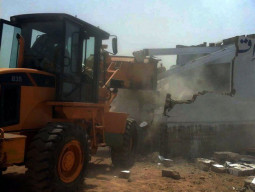
We inherited, at the time of independence, traditions of heritage conservation dating back to the 19th century British raj. It began in 1881, when the British Lord Viceroy Lytton appointed Major Cole as a curator for the ancient monuments of then British India. Later, after the appointment of Lord Curzon as Viceroy, the legislation of antiquities and monuments was introduced, which formed the basis of the Ancient Monument Preservation Act of 1904, which was adopted by Pakistan in 1947. This act remained intact with very few, minor changes until 1968, when Pakistan passed its own Antiquities Act that retained most of the clauses of the AMP Act, albeit in a modified form. Despite all this, our heritage sites have largely not been preserved or put to beneficial adaptive reuse, particularly in the urban landscape of Pakistan.
Karachi, for example, has seen its architectural and historic heritage suffer badly, as uncontrolled and unregulated urbanisation has defaced and defiled the colonial structures and spaces.
Read: Karachi artists reclaim city walls from hate graffiti
Change of land use, urban pollution and inappropriate renovation efforts are some of the causes of this alarming and tragic loss of architectural heritage. For things to improve, efforts have to be initiated on a number of fronts. To begin with, there is an urgent need to document, in a comprehensive manner, using modern documentation tools and strategies, the various aspects of the historical and architectural sites.
An initiative to address this deficit has been undertaken by architect Marvi Mazhar and her team. In the project of Historic Bungalow Research (HBR), she is heading a team that is documenting and profiling century old bungalows across Pakistan for archival purposes, looking at immigrant architectural style of bungalows belonging to the pre- and post-partition eras, with a strong focus on Karachi. Mazhar strongly feels that educating current and future generations about the existence and beauty of these historic bungalows is imperative for understanding the history of our nation.
She explains that the roots of South Asian bungalows lie in the early attempts of British engineers to design standardised and permanent dwellings based on indigenous domestic structures. Currently, documentation is taking place of historic bungalows depicting varying styles, particularly Hindu, Sikh, colonial and Art Deco. The research process involves using historical records and meeting people and institutions for identification of bungalows, understanding their history, doing extensive field work, photographic documentation and sketching.
Read: A journey through Karachi’s past and present
According to Marvi, while they have received support from government departments, such as the antiquities and culture department, the success of the project is based on building relationships based on trust with the users of the historic bungalows and having a two way learning process to understand the history of a particular bungalow in terms of how users and functional uses have changed over time and how such structures can be best preserved for the future.
To ensure that the documented record of these bungalows is better secured and can be utilised for comprehensive heritage assessment studies and for implementing more sophisticated and advanced preservation, restoration and renovation strategies and techniques, the collected data is being digitised with plans for mapping these bungalows in a historic quarters-based urban map using Geographic Information Systems mapping. Once the detailed documentation is completed, it should lead to the structuring of a strategic and planning framework for preserving our historical heritage.
The writer is an urban planner and runs a non-profit organisation based in Karachi city focusing on urban sustainability issues
Published in The Express Tribune, August 31st, 2015.
1719660634-1/BeFunky-collage-nicole-(1)1719660634-1-405x300.webp)

1732276540-0/kim-(10)1732276540-0-165x106.webp)

1732274008-0/Ariana-Grande-and-Kristin-Chenoweth-(1)1732274008-0-165x106.webp)












COMMENTS
Comments are moderated and generally will be posted if they are on-topic and not abusive.
For more information, please see our Comments FAQ